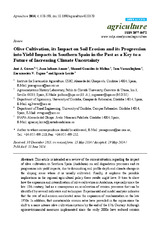Olive Cultivation, its Impact on Soil Erosion and its Progression into Yield Impacts in Southern Spain in the Past as a Key to a Future of Increasing Climate Uncertainty
Autor
Gómez, J.A.
Infante-Amate, Juan
González de Molina Navarro, Manuel
Taguas Ruiz, Encarnación
Lorite Torres, Ignacio
Vanwalleghem, Tom
Editor
MDPIFecha
2014Materia
Olive treeHistory
Soil erosion
Water balance
Southern Spain
Yield
Climate change
METS:
Mostrar el registro METSPREMIS:
Mostrar el registro PREMISMetadatos
Mostrar el registro completo del ítemResumen
This article is intended as a review of the current situation regarding the impact
of olive cultivation in Southern Spain (Andalusia) on soil degradation processes and its
progression into yield impacts, due to diminishing soil profile depth and climate change in
the sloping areas where it is usually cultivated. Finally, it explores the possible
implications in the regional agricultural policy these results might have. It tries to show
how the expansion and intensification of olive cultivation in Andalusia, especially since the
late 18th century, had as a consequence an acceleration of erosion processes that can be
identified by several indicators and techniques. Experimental and model analysis indicates
that the rate of soil erosion accelerated since the expansion of mechanization in the late
1950s. In addition, that unsustainable erosion rates have prevailed in the region since the
shift to a more intense olive cultivation systems by the end of the 17th Century. Although
agroenvironmental measures implemented since the early 2000s have reduced erosion rates, they are still unsustainably high in a large fraction of the olive area in the region.
In the case of olive orchards located in steeper areas with soils of lower water-holding
capacity (due to coarse texture and stone content), cumulative erosion has already had a
high impact on reducing their potential productivity. This is one of the factors that
contributes towards increasing the gap between these less intensified orchards in the
mountainous areas and those in the hilly areas with more gentle slopes, such as for instance
the lower stretches of the Guadalquivir River Valley. In the case of olive orchards in the
hilly areas with better soils, easier access to irrigation and lower production costs per unit,
the efforts on soil conservation should be oriented towards limiting off-site damage, since
the soil water-storage function of these soils may be preserved in the medium term even at
the current soil erosion rates. The assessment made in this manuscript should be regarded
as an initial approximation, since additional efforts in terms of increasing experimental
records (for current or historical erosion) and of improving model analysis, with more
comprehensive studies and more robust calibration and validation processes, are required.

